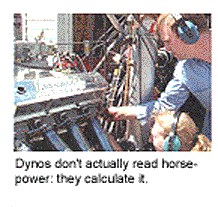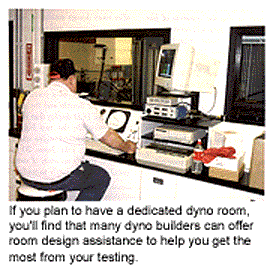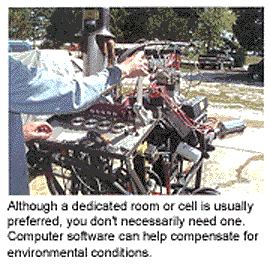A dyno can give an engine builder an enormous wealth of information and even separate the truth from lies. It’s one thing for a builder to have an idea of what the engine he or she is building is capable of and quite another to know exactly what’s been created. That’s because a dyno, more formally known as a dynamometer, is more than something that can just read an engine’s horsepower.

Actually, a dyno doesn’t even read horsepower. A dyno can measure engine speed, torque, fuel flows, acceleration, air flows, liquid flows, air temperature, exhaust gas temperatures, liquid temperatures, oil pressure, manifold pressure, barometric pressure, humidity, analog voltages and more. With those known values, it can then calculate engine power, corrected power, air/fuel ratio, brake specific fuel consumption, brake specific air consumption, volumetric efficiency and mechanical efficiency. In fact, there is an entire science of dyno development for wringing out an engine for any and virtually all specific usage.
Dyno builders are quick to point out the many benefits to using a dyno but the most common is to know exactly what horsepower an engine is producing and where it factors into its power curve. Horsepower (HP) is a simple equation that is math, not a measured value. It’s the ratio of torque and RPM (T X RPM/5252 = HP) torque rating and at what RPM is what should be considered as far as power absorption capacity. It’s the job of the dyno to absorb the torque and that info translates into HP.
That means that a builder can not only test the engine for horsepower and torque but can test and evaluate an exhaust system, a fuel delivery system, where the cam produces power better, lubricants, performance coatings, bearings, durability issues and even track performance simulations. The list, of course, goes on and on so it’s better we tell you what dynos have to offer and that way you can decide what you might want to test.
First the good news – sort of. A builder does not have to have a separate room or cell for a dyno. Dyno cells are more for a stable environment for the engine rather than the dyno. So while it is a better idea to have one, it isn’t always needed. But keep in mind, that by not controlling elements such as oil and water temp and more importantly the quality and quantity of the air the engine is ingesting, your readings could be off by as much as 10 percent. And without the weather testing gear most dynos use, you may not be able repeat your test results. Room ventilation is often overlooked as an important consideration of engine room test-cell design. Yet, air is one of the most critical properties of the combustion process, so it doesn’t take much to see how the air going into your dyno needs to be consistent and monitored.
There is also the question of just how much air a dyno will need to operate correctly. Some manufacturer guidelines suggest 10-15 times the cubic feet of your room in cubic feet of airflow per minute. Those requirements could be higher depending on your power level.
The other, more important, aspect is the clearing of the dyno-cell when the test has been completed. The combined fumes from an alcohol-burning engine, for one potentially deadly example, can overpower anyone entering the dyno area. Many dyno builders offer room design assistance and can give you drawings and documents on how to construct a cell to get the most from your testing.
Dynos consist of a control panel, the load device and the assembly that will house the engine during testing. What’s available on a control panel? The manual throttle and the gauge or large color LCD display that indicates horsepower are the two biggies. A meter for torque and engine speed can also display info from 20 other sources. There’s an array of switches, usually the rocker style to confirm status and many times they can be lighted. A large, easy to reach emergency kill switch is prominent as are single push switches for the starter, fuel and ignition among others.
Many systems also offer complete dyno cell controls including lights, fans, heaters and pumps so the operator can control them directly from the console.

A second data display can be used for current or stored data from a multitude of sources and on different screens. This second screen can often be used to start, pause and stop tests. Dial gauges are also used for temps and pressures. Some dynos offer a LCD touch screen controller and knobs for setting engine speeds and oil or water temperatures.
There’s a control panel on the engine side of the dyno that will usually contain a starter switch that can be used to ‘bump’ the engine for adjusting valves or just to rotate the crank. Often the starter switch may be two switches so one can be reached from either side of the engine. Large liquid-filled pressure gauges are the norm on the dyno control panel showing fuel and oil pressures.
The load device, most commonly a waterbrake, is used to control the load on the engine and works by opening and closing the valves and water flow. Some units have one valve on the inlet while a few have them on the outlet, too. Water inlet and outlet controls for load control and repeatability or precise control of the water equates to precise control of the load applied to the engine.
Many times a fast responding microprocessor is used to drive the valves so that changes to the load are more accurate. If your customer market includes sudden load changes for items such as nitrous oxide, you will need more refined controls on the waterbrake to absorb spikes in torque and power. And, like the air, water temperature may need to compensated in the load cell for consistency and accuracy.
For the engine stand, your choice includes such fancy options as full-capability engine docking carts that eliminate the need for a starter, bellhousing and flywheel. The unit bolts directly to the engine’s crankshaft. Nice, yes, but the functionality of these units is even more valuable. One bonus is more clearance for headers and exhaust.
High performance fuel pumps, filters and regulators ensure consistent flow with an accumulator that maintains pressure and gives better flow measurements. Quick disconnect fuel and coolant lines with shut off valves help to speed up swaps and changes.
A mechanical boom for lifting the engine on and off the dyno can also serve as a bridge for wiring and plumbing to safely reach the engine with the utmost clearance. Some dynos have them built in and some also include tool and parts storage trays. Other dyno hardware includes such items as engine cooling provisions with tower storage, starter, bellhousing and electrical quick disconnects.
Inertia Correlation
The faster the “pull” or “sweep” of the engine, the more chance for error readings. This is caused by inertia and inertia correlation corrects for that – but remember, torque will read less on acceleration. Units that test at different sweep rates give a better cross section of where the torque is on an engine and would otherwise be undetected by uncorrected torque errors.
That’s where the dyno’s computer comes in. Corrections are constantly made at the rate of hundreds of times a second and at every 100 rpm. Some software systems allow the user to configure his own correction values. And if a builder wanted to test without the corrections, the system can be disabled on pulls if needed.
Dyno Computers
A dyno computer is more than just a monitoring device. And before you can talk software, you need to establish basic computer hardware parameters. The computers used to run extensive programs crunching data to give operators the best info are particular to dynos. In other words, you can’t run a home computer with a simple Windows program and expect great results. You’ll need a state of the art computer with high-speed power to work over all that data. It will need to be an industrial-quality system to withstand the vibration, heat and even radiated energies the engine and its ignition will produce.

You’ll need a larger color monitor, usually 17 inches or more and, of course, a printer. Look not only for your computer to be industrial grade but the peripherals of monitor, plotter/printer, controller and keyboard as well.
Dyno computers need to have numerous real-time input channels as well as built-in alarms and limits. Channels include torque input, RPM input, fuel flow measurements at
gallons per minute (GPM), oil and fuel pressure, oil, coolant and fuel temperatures, dyno water out temperature, a weather station of barometric pressure, humidity and ambient air temperature and calculation channels. Having up to 200 channels is not unusual. Be sure the channels can be calibrated via the keyboard as per your needs and keep extra open
channels for future input.
Software
Once you have the right hardware, the software needed should be, at the very least, compatible with the dyno. A powerful integrated data analysis and graphing package is needed along with a graphical software based program. Many programs offer standard and user-created test programs. The programs that the user creates are made more simple with standard computer methods such as copy, cut and paste steps.
For graph pages, look for your software to have at least six graph and numeric pages to evaluate data. Usually more than half of them can be plotted for operator selected data channels. Most units also allow for numerous runs to be plotted against each other for comparison and evaluation. Info can be displayed in both graph and numerical forms.
Some software allows the user to configure and store their own tests, see the data readout in real-time and even playback tests as part of their test-cell controls implementations.
Many dyno computers offer online service capabilities where the manufacturer can see your system and help troubleshoot at your location. It’s also a great way to download upgrades to your software.
One of the basic jobs of dyno software is to integrate – preferably seamlessly – devices such as the dyno with the throttle, spark and fuel controllers, cell safety systems, emissions analyzers, driver’s aid consoles, environmental controls and any other so called “Smart” Input/Output devices.
There are systems that are not built by the dyno companies but work with virtually all brands of dynos. They offer builders the chance to write their own tests without having to “learn” a computer programming language. Limits and alarm activations can also be programmed into any and all tests. Most software is also easily logged onto disc or printer and exportable to compatible proprietary programs such as Excel, Word, HiQ, MATHCAD and others compatible with conventional Microsoft Windows programming skills.
Chassis Dynos
If as an engine builder you’re also involved with the other components of the driveline such as transmissions, transaxles, rear ends and front wheel drive assemblies you may want to think about a chassis dyno. Much like its name, a chassis dyno primarily discloses how much power is delivered to the drive wheels. Most chassis dynos work in both two and four wheel drive modes making them readily adaptable to most any car or light truck.
A chassis dyno can measure roll speeds, torque, acceleration, fuel flows, air flows, lambdas, liquid flows, air temperatures, exhaust gas temperatures, liquid temperatures, oil pressure, manifold pressure, barometric pressure, humidity, analog voltages and more. Chassis dynos can test full exhaust systems, lubricants, performance coatings, pinion angle alignment, axle bearings and U-joints. Operators can quantify tire, clutch, or torque converter slip without more expensive track testing. They usually work up to 200 mph (accuracy +/- 0.1 mph) and handle up 1,500 horsepower. The larger models can handle vehicles up to 10,000 lbs. while smaller models can take 7,000 lb. vehicles. Most can run the tests from the car’s driver’s seat using a small control panel and are great for troubleshooting drivability problems. Testing the car on a dyno means the car’s computers are also tested and seen interfacing with the engine and driveline equipment.
Much of the software on chassis dynos is similar in function to engine dynos in that formatted and customized tests can be run. Programs can include short run durability tests, track lap tests, simulate varying grades of hills, stoplight-to-stoplight driving and constant or variable speeds. And like the built-in factors for inertia corrections, chassis dynos take in consideration for bearing and aerodynamic losses.
Race teams like to use the dynos to look for drag and power loss on the various components such as dragging brakes and wheel bearings during coast down and deceleration.
The rollers on a chassis dyno come in single and double configurations and are sized to provide minimum tire distortion and heating at speed. The rollers can be knurled for better traction and minimum tire noise and work in forward and reverse. There are a few styles of chassis dynos from the simple cradle roll that fits one axle to two- and four- wheel-drive large rolls that fit one or both axles. And yes, there are even dedicated dynos for motorcycles, but that’s another story.
If you know how to ask the right questions, dynos can give you the right answers, and that’s no lie.













